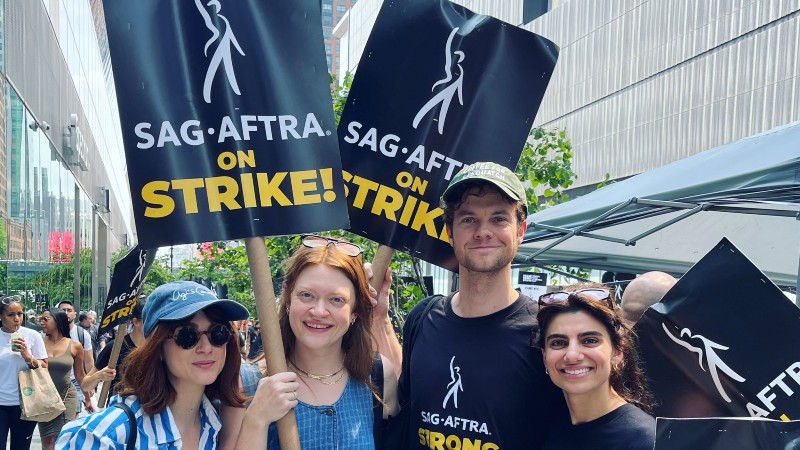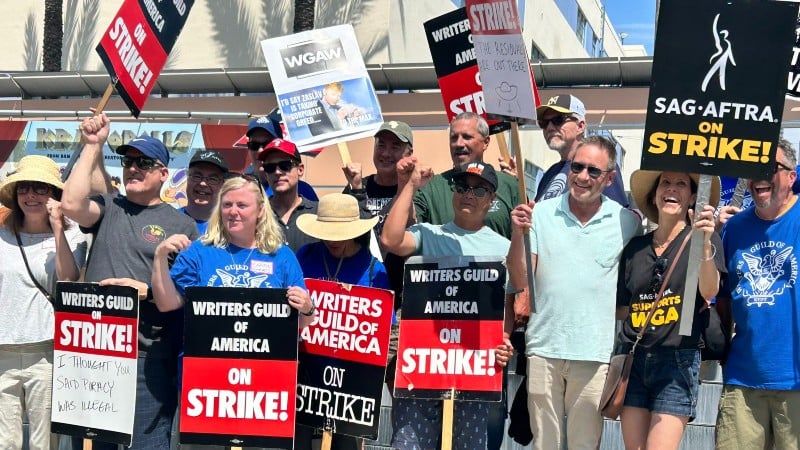On July 13th, 2023, the Screen Actors Guild-American Federation of Television and Radio Artists – better known as SAG-AFTRA – voted to authorize a labor strike. This marks a historic moment for Hollywood since it’s the first actors’ strike in fifty years, as well as the first time both actors and writers have been on strike in decades. In addition, the onset of the SAG-AFTRA strike is going to coincide with Comic-Con 2023, which has raised a few important questions about how the strike is going to affect the way conventions work for fans and actors alike.
If you’re trying to keep on top of the news surrounding the SAG-AFTRA strike, then have no fear. We’ve compiled a guide of everything you’ll need to know about the strike.
When Did the SAG-AFTRA Strike Begin?

The SAG-AFTA Negotiating Committee officially authorized a labor strike on July 13th, 2023, with the strike order going into effect at 12:01 A.M. on July 14th. SAG-AFTRA president Fran Drescher (The Nanny) announced the strike in a televised press conference, in which she called the Alliance of Motion Picture and Television Producers (AMPTP) a “greedy entity” that has been “[pleading] poverty” while campaigning for updated actors’ contracts in the face of the new business model streaming has brought to Hollywood.
The effects of the strike were felt almost immediately after the announcement, with news headlines highlighting the walkout at the London premiere of Oppenheimer. Emily Blunt, Matt Damon, Cillian Murphy, and Florence Pugh briefly appeared on the red carpet before leaving. Director Christopher Nolan told the press they were “off to write their picket signs.”
Why is SAG-AFTRA Striking?
The short answer to this question is that while Hollywood’s business model has undergone massive changes in recent years, the AMPTP has refused to make accompanying changes to actors’ contracts. With the rising popularity of streaming platforms like Netflix, Amazon Prime Video, Paramount+, and others, the way actors are paid has changed since they no longer earn residual pay from big theatrical releases or reruns of their TV shows or movies.

If you’re familiar with the ongoing Writers’ Guild of America strike, then SAG-AFTRA’s reasons for striking may seem familiar. The WGA strike commenced on May 2nd for similar reasons, in addition to writers protesting Hollywood producers’ increased use of AI-generated screenplays. The actors’ strike has comparable concerns regarding AI, with one of AMPTP’s negotiation proposals reportedly including “a groundbreaking AI proposal that protects actors’ digital likenesses for SAG-AFTRA members.”
As exciting as that idea sounds, SAG-AFTRA Chief Negotiator Duncan Crabtree-Ireland said that the full details of the proposal meant that actors would be scanned into a digital likeness, given one day’s pay. Additionally, their AI likeness would be used “for the rest of eternity on any project they want, with no consent and no compensation.”
What’s So Important About the SAG-AFTRA & WGA Double Strike?
If you’ve been paying attention to the news surrounding the SAG-AFTRA strike, you might have noticed some excitement about the fact that the SAG-AFTRA and the WGA are on strike at the same time. Obviously, both writers and actors being on strike will cause major delays and maybe even shutdowns in Hollywood. Hence, the decision for both guilds to be striking at once is a weighty decision to make. However, by standing in solidarity, the WGA and SAG-AFTRA are increasing pressure on the producers to compromise with each guild’s proposals.

The last time both the SAG-AFTRA and the WGA were on strike was in 1960. At that time, future U.S. President Ronald Reagan served as the Screen Actors Guild’s president. Actors were on strike to protest the way movie actors were being paid more than TV actors despite the way shows like Leave it to Beaver and Beverly Hillbillies were on the rise in the 60s. The 1960s strike was the driving force behind the creation of residuals, which give actors a cut of the pay each time their TV show or movie is rerun. This model served Hollywood well until the rise of streaming eliminated the concept of reruns altogether.
What Does the SAG-AFTRA Strike Mean for Non-Actors?
Aside from halting movie production for the time being, the SAG-AFTRA strike is going to have an effect on the way movies are promoted. With San Diego Comic-Con right around the corner, many people have had questions about how the strike will affect conventions, too. A full list of SAG-AFTRA’s strike guidelines can be found on their FAQ pages. Still, some highlights include SAG-AFTRA dictating that influencers and fans cannot promote any work by the companies the guild is striking again. This includes making appearances at conventions, doing fan meet-and-greets, and social media promotions of struck work.
Importantly, SAG-AFTRA has not called for a boycott at this time. This means that audiences can still watch shows on platforms like Netflix, Amazon, Peacock, and others without violating the strike guidelines, so feel free to binge-watch to your heart’s content while we wait for actors, screenwriters, and producers to come to an agreement that benefits everyone involved.





